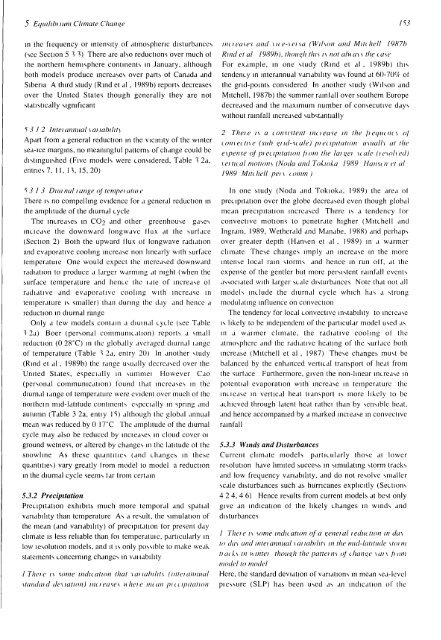First Assessment Report - IPCC
First Assessment Report - IPCC
First Assessment Report - IPCC
You also want an ePaper? Increase the reach of your titles
YUMPU automatically turns print PDFs into web optimized ePapers that Google loves.
J Equilibi mm Climate Change IS 3<br />
in the fiequency or intensity of atmospheric disturbances<br />
(see Section 5 3 3) There are also reductions over much of<br />
the northern hemisphere continents in January, although<br />
both models produce increases over parts ot Canada and<br />
Siberia A third study (Rind et al , 1989b) reports decreases<br />
over the United States though generally they are not<br />
statistically significant<br />
5 3 I 2 Intel annual \ai iabilit\<br />
Apart from a general reduction in the vicinity of the winter<br />
sea-ice margins, no meaningful patterns of change could be<br />
distinguished (Five models were considered. Table 3 2a,<br />
entries 7, 11, 13, 15,20)<br />
S 3 1 3 Dim nal i ange of tempo aim e<br />
There is no compelling evidence for a general reduction in<br />
the amplitude of the diurnal cycle<br />
The increases in CCb and other greenhouse gases<br />
incicase the downward longwave flux at the surface<br />
(Section 2) Both the upward flux of longwave radiation<br />
and evaporative cooling increase non linearly with surface<br />
temperatuie One would expect the increased downward<br />
radiation to produce a larger warming at night (when the<br />
surface temperature and hence the iate of increase of<br />
radiative and evaporative cooling with increase in<br />
temperature is smaller) than during the day and hence a<br />
reduction in diurnal range<br />
Only a few models contain a diurnal cycle (see Table<br />
3 2a) Boer (personal communication) reports a small<br />
reduction (0 28°C) in the globally averaged diurnal iange<br />
of temperature (Table 3 2a, entry 20) In another study<br />
(Rind et al , 1989b) the range usually decreased over the<br />
United States, especially in summei However Cao<br />
(personal communication) found that increases in the<br />
diurnal iange of temperature were evident over much of the<br />
noithein mid-latitude continents especially in spring and<br />
autumn (Table 3 2a, entiy 15) although the global annual<br />
mean was reduced by 0 17°C The amplitude of the diurnal<br />
cycle may also be reduced by incieases in cloud cover oi<br />
ground wetness, or altered by changes in the latitude ol the<br />
snowline As these quantities (and changes in these<br />
quantities) vary greatly from model to model a reduction<br />
in the diurnal cycle seems far lrom certain<br />
5.3.2 Precipitation<br />
Precipitation exhibits much more temporal and spatial<br />
variability than temperature As a result, the simulation of<br />
the mean (and variability) of precipitation for present day<br />
climate is less reliable than foi temperatuie, particularly in<br />
low iesolution models, and it is only possible to make weak<br />
statements concerning changes in vai lability<br />
/ Tlwie is some indication that \aiiabilit\ (uiteiannual<br />
standaid deviation) mcteases whew mean pucipitation<br />
incieases and \ice-\eisa (Wilson and Mitchell 1987b<br />
Rind et al 1989b), though this is not alwas s the case<br />
For example, in one study (Rind et al , 1989b) this<br />
tendency in interannual variability was found at 60-70% of<br />
the grid-points considered In another study (Wilson and<br />
Mitchell, 1987b) the summer rainfall over southern Europe<br />
decreased and the maximum number of consecutive days<br />
without rainfall increased substantially<br />
2 Theie is a consistent inciease in the fiec/ucncs of<br />
comectne (sub t>i td-scale) pi capitation usualh at the<br />
expense of pi capitation pom the laiqei scale (icsohed)<br />
\eitical motions (Noda and Tokioka 1989 Hansen el al<br />
1989 Mitchell peis comm )<br />
In one study (Noda and Tokioka, 1989) the area of<br />
precipitation over the globe decreased even though global<br />
mean precipitation increased There is a tendency for<br />
convective motions to penetrate higher (Mitchell and<br />
Ingram, 1989, Wetherald and Manabe, 1988) and perhaps<br />
over greater depth (Hansen et al , 1989) in a warmer<br />
climate These changes imply an increase in the more<br />
intense local rain storms and hence in run off, at the<br />
expense of the gentler but more persistent rainfall events<br />
associated with larger scale disturbances Note that not all<br />
models include the diurnal cycle which has a strong<br />
modulating influence on convection<br />
The tendency for local convective instability to inciease<br />
is likely to be independent of the particular model used as<br />
in a wanner climate, the radiative cooling of the<br />
atmosphere and the radiative heating of the surtace both<br />
increase (Mitchell et al , 1987) These changes must be<br />
balanced by the enhanced vertical transport of heat from<br />
the surtace Furthermore, given the non-linear increase in<br />
potential evaporation with increase in temperature the<br />
inciease in vertical heat tiansport is more likely to be<br />
achieved through latent heat rathei than by sensible heat,<br />
and hence accompanied by a marked inciease in convective<br />
rainfall<br />
5.3.3 Winds and Disturbances<br />
Current climate models particularly those at lower<br />
resolution have limited success in simulating storm tracks<br />
and low frequency variability, and do not resolve smaller<br />
scale disturbances such as hurricanes explicitly (Sections<br />
4 2 4, 4 6) Hence results from current models at best only<br />
give an indication of the likely changes in winds and<br />
disturbances<br />
/ Thcie is some indication of a i>eneial i eduction in das<br />
to das and mteiannual \auabilits in the mid-latitude \toim<br />
tiaiks in wmtei though the patterns of change \ai\ pom<br />
model to model<br />
Here, the standard deviation of variations in mean sea-level<br />
picssure (SLP) has been used as an indication of the
















